Case Scenario 3: Community Nursing Interventions for HIV in Australia
VerifiedAdded on 2019/12/28
|11
|2787
|54
Report
AI Summary
This report examines community nursing interventions for HIV patients in Australia, focusing on the principles of equity and access within primary health care. It describes key populations disproportionately affected by HIV, their associated risks, and the challenges they face regarding equity and access to healthcare services. The report uses Case Scenario 3, involving HIV, as an example of community nursing intervention and approaches to support preventive health care services and promote health for key populations affected by HIV. The analysis covers nursing interventions, the importance of health equity, and the need for community nurses to address discrimination and ensure access to quality healthcare. The report highlights the increasing prevalence of HIV among Australian women, the role of sexual transmission, and the importance of providing accurate health information and support services. The conclusion summarizes the key findings and emphasizes the need for continued efforts to address HIV in Australia.

CASE SCENARIO 3 HIV
Paraphrase This Document
Need a fresh take? Get an instant paraphrase of this document with our AI Paraphraser
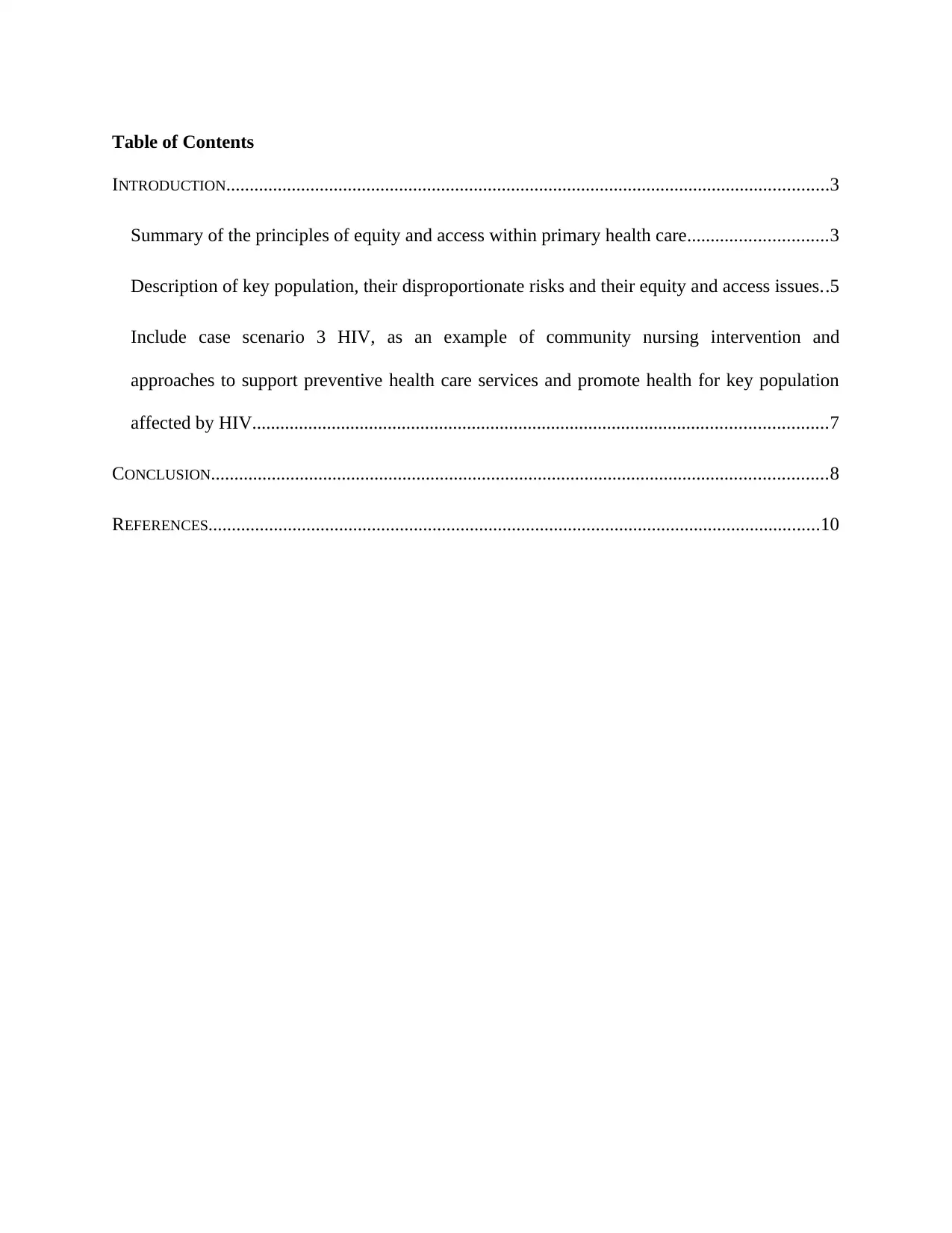
Table of Contents
INTRODUCTION.................................................................................................................................3
Summary of the principles of equity and access within primary health care..............................3
Description of key population, their disproportionate risks and their equity and access issues..5
Include case scenario 3 HIV, as an example of community nursing intervention and
approaches to support preventive health care services and promote health for key population
affected by HIV...........................................................................................................................7
CONCLUSION....................................................................................................................................8
REFERENCES...................................................................................................................................10
INTRODUCTION.................................................................................................................................3
Summary of the principles of equity and access within primary health care..............................3
Description of key population, their disproportionate risks and their equity and access issues..5
Include case scenario 3 HIV, as an example of community nursing intervention and
approaches to support preventive health care services and promote health for key population
affected by HIV...........................................................................................................................7
CONCLUSION....................................................................................................................................8
REFERENCES...................................................................................................................................10
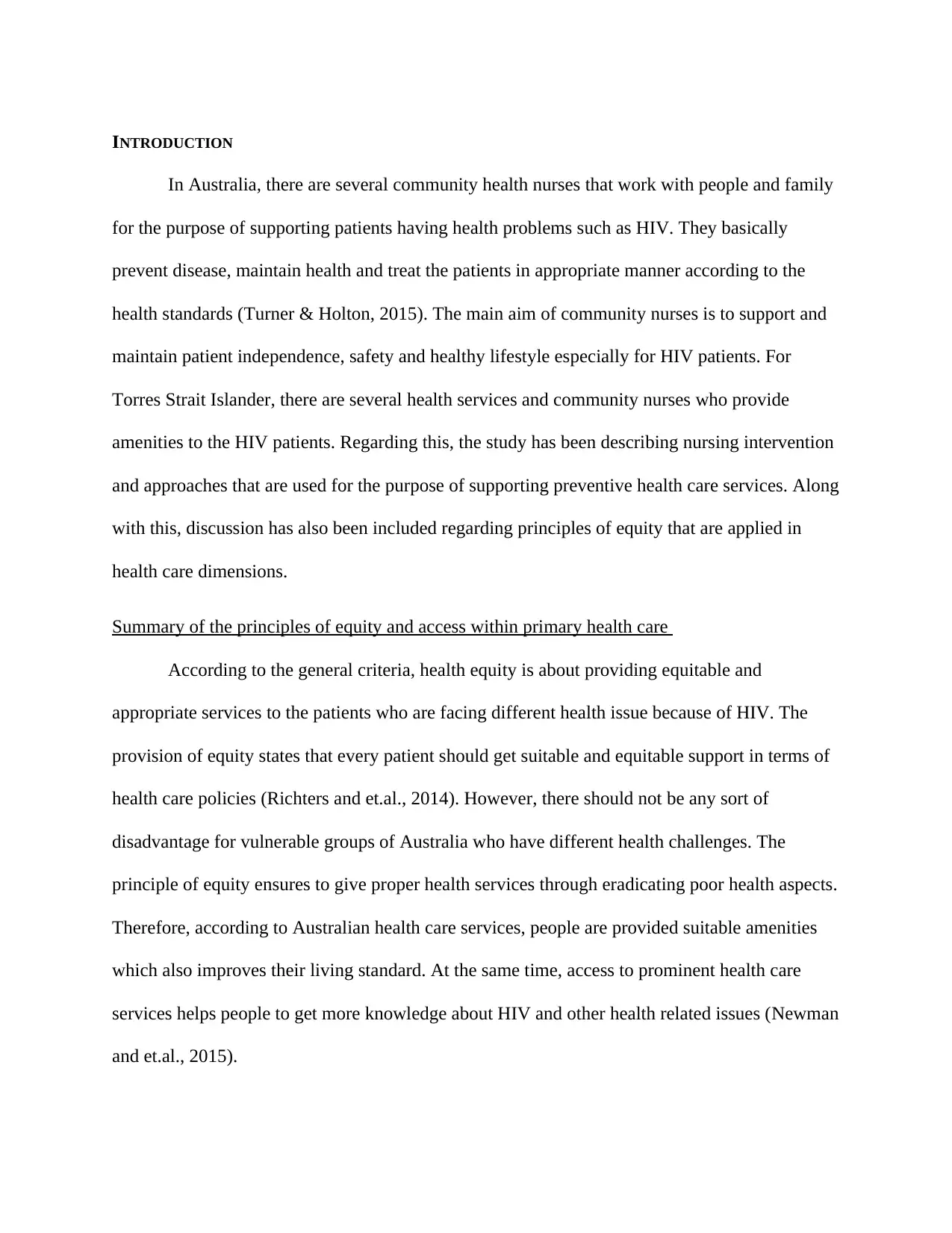
INTRODUCTION
In Australia, there are several community health nurses that work with people and family
for the purpose of supporting patients having health problems such as HIV. They basically
prevent disease, maintain health and treat the patients in appropriate manner according to the
health standards (Turner & Holton, 2015). The main aim of community nurses is to support and
maintain patient independence, safety and healthy lifestyle especially for HIV patients. For
Torres Strait Islander, there are several health services and community nurses who provide
amenities to the HIV patients. Regarding this, the study has been describing nursing intervention
and approaches that are used for the purpose of supporting preventive health care services. Along
with this, discussion has also been included regarding principles of equity that are applied in
health care dimensions.
Summary of the principles of equity and access within primary health care
According to the general criteria, health equity is about providing equitable and
appropriate services to the patients who are facing different health issue because of HIV. The
provision of equity states that every patient should get suitable and equitable support in terms of
health care policies (Richters and et.al., 2014). However, there should not be any sort of
disadvantage for vulnerable groups of Australia who have different health challenges. The
principle of equity ensures to give proper health services through eradicating poor health aspects.
Therefore, according to Australian health care services, people are provided suitable amenities
which also improves their living standard. At the same time, access to prominent health care
services helps people to get more knowledge about HIV and other health related issues (Newman
and et.al., 2015).
In Australia, there are several community health nurses that work with people and family
for the purpose of supporting patients having health problems such as HIV. They basically
prevent disease, maintain health and treat the patients in appropriate manner according to the
health standards (Turner & Holton, 2015). The main aim of community nurses is to support and
maintain patient independence, safety and healthy lifestyle especially for HIV patients. For
Torres Strait Islander, there are several health services and community nurses who provide
amenities to the HIV patients. Regarding this, the study has been describing nursing intervention
and approaches that are used for the purpose of supporting preventive health care services. Along
with this, discussion has also been included regarding principles of equity that are applied in
health care dimensions.
Summary of the principles of equity and access within primary health care
According to the general criteria, health equity is about providing equitable and
appropriate services to the patients who are facing different health issue because of HIV. The
provision of equity states that every patient should get suitable and equitable support in terms of
health care policies (Richters and et.al., 2014). However, there should not be any sort of
disadvantage for vulnerable groups of Australia who have different health challenges. The
principle of equity ensures to give proper health services through eradicating poor health aspects.
Therefore, according to Australian health care services, people are provided suitable amenities
which also improves their living standard. At the same time, access to prominent health care
services helps people to get more knowledge about HIV and other health related issues (Newman
and et.al., 2015).
⊘ This is a preview!⊘
Do you want full access?
Subscribe today to unlock all pages.

Trusted by 1+ million students worldwide
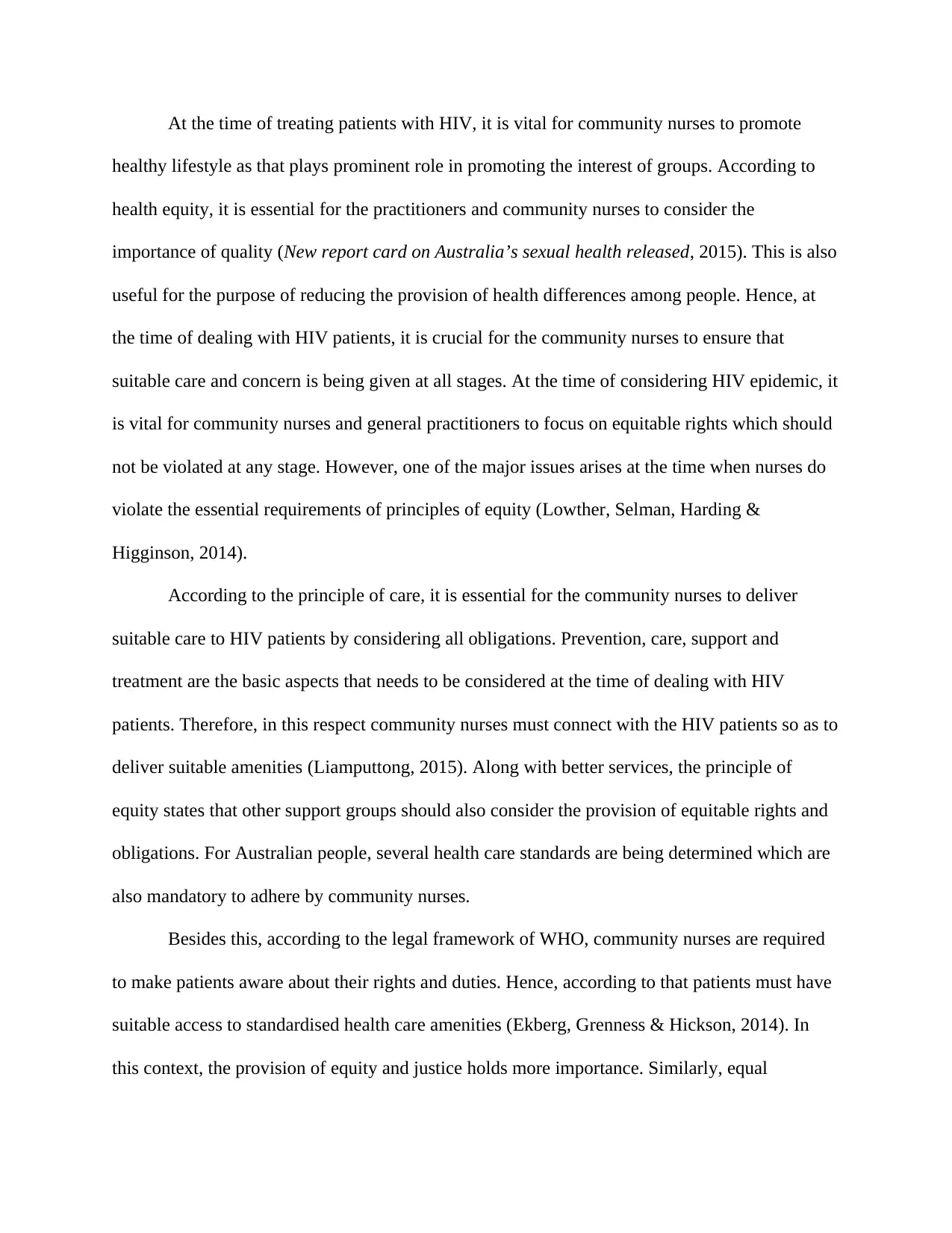
At the time of treating patients with HIV, it is vital for community nurses to promote
healthy lifestyle as that plays prominent role in promoting the interest of groups. According to
health equity, it is essential for the practitioners and community nurses to consider the
importance of quality (New report card on Australia’s sexual health released, 2015). This is also
useful for the purpose of reducing the provision of health differences among people. Hence, at
the time of dealing with HIV patients, it is crucial for the community nurses to ensure that
suitable care and concern is being given at all stages. At the time of considering HIV epidemic, it
is vital for community nurses and general practitioners to focus on equitable rights which should
not be violated at any stage. However, one of the major issues arises at the time when nurses do
violate the essential requirements of principles of equity (Lowther, Selman, Harding &
Higginson, 2014).
According to the principle of care, it is essential for the community nurses to deliver
suitable care to HIV patients by considering all obligations. Prevention, care, support and
treatment are the basic aspects that needs to be considered at the time of dealing with HIV
patients. Therefore, in this respect community nurses must connect with the HIV patients so as to
deliver suitable amenities (Liamputtong, 2015). Along with better services, the principle of
equity states that other support groups should also consider the provision of equitable rights and
obligations. For Australian people, several health care standards are being determined which are
also mandatory to adhere by community nurses.
Besides this, according to the legal framework of WHO, community nurses are required
to make patients aware about their rights and duties. Hence, according to that patients must have
suitable access to standardised health care amenities (Ekberg, Grenness & Hickson, 2014). In
this context, the provision of equity and justice holds more importance. Similarly, equal
healthy lifestyle as that plays prominent role in promoting the interest of groups. According to
health equity, it is essential for the practitioners and community nurses to consider the
importance of quality (New report card on Australia’s sexual health released, 2015). This is also
useful for the purpose of reducing the provision of health differences among people. Hence, at
the time of dealing with HIV patients, it is crucial for the community nurses to ensure that
suitable care and concern is being given at all stages. At the time of considering HIV epidemic, it
is vital for community nurses and general practitioners to focus on equitable rights which should
not be violated at any stage. However, one of the major issues arises at the time when nurses do
violate the essential requirements of principles of equity (Lowther, Selman, Harding &
Higginson, 2014).
According to the principle of care, it is essential for the community nurses to deliver
suitable care to HIV patients by considering all obligations. Prevention, care, support and
treatment are the basic aspects that needs to be considered at the time of dealing with HIV
patients. Therefore, in this respect community nurses must connect with the HIV patients so as to
deliver suitable amenities (Liamputtong, 2015). Along with better services, the principle of
equity states that other support groups should also consider the provision of equitable rights and
obligations. For Australian people, several health care standards are being determined which are
also mandatory to adhere by community nurses.
Besides this, according to the legal framework of WHO, community nurses are required
to make patients aware about their rights and duties. Hence, according to that patients must have
suitable access to standardised health care amenities (Ekberg, Grenness & Hickson, 2014). In
this context, the provision of equity and justice holds more importance. Similarly, equal
Paraphrase This Document
Need a fresh take? Get an instant paraphrase of this document with our AI Paraphraser
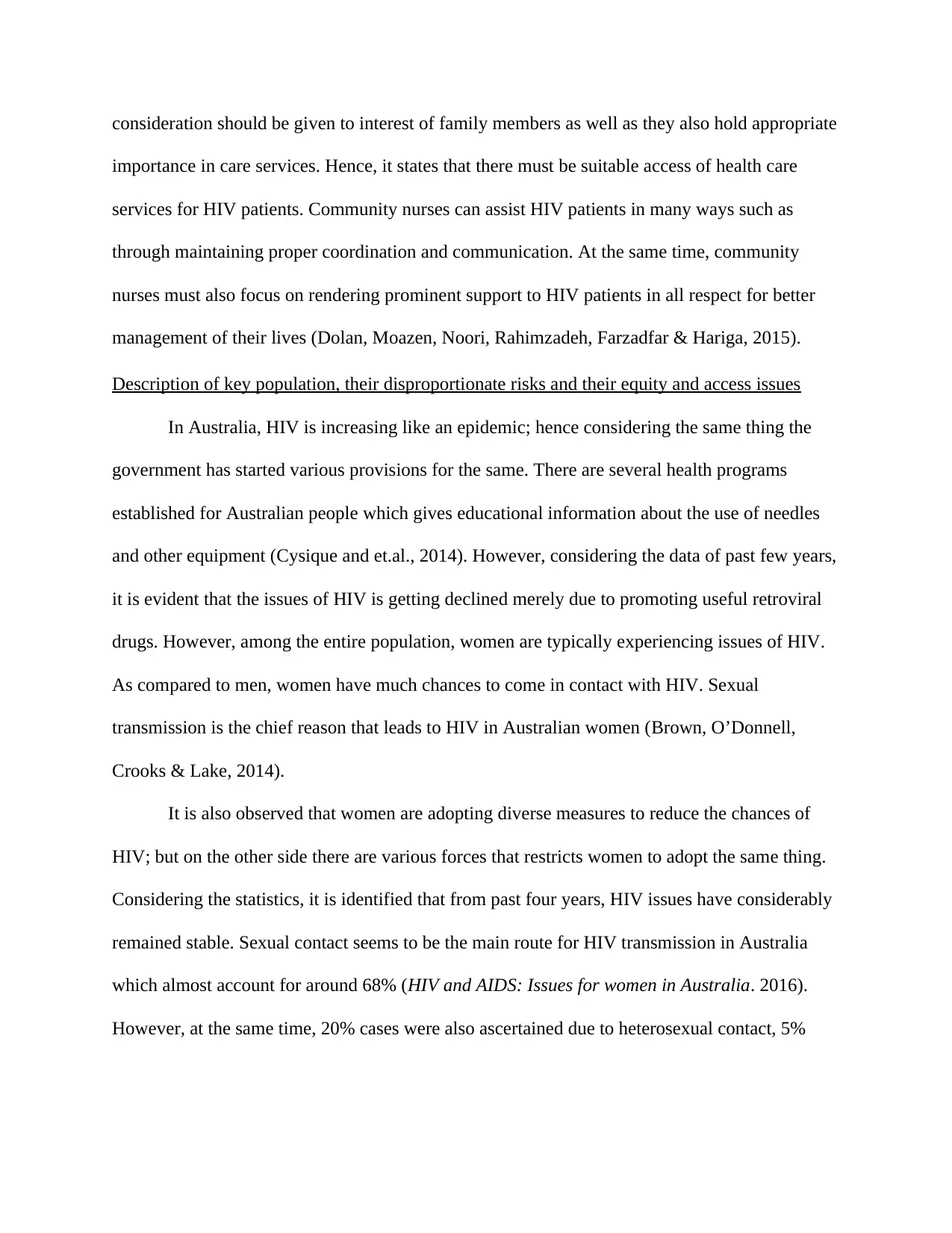
consideration should be given to interest of family members as well as they also hold appropriate
importance in care services. Hence, it states that there must be suitable access of health care
services for HIV patients. Community nurses can assist HIV patients in many ways such as
through maintaining proper coordination and communication. At the same time, community
nurses must also focus on rendering prominent support to HIV patients in all respect for better
management of their lives (Dolan, Moazen, Noori, Rahimzadeh, Farzadfar & Hariga, 2015).
Description of key population, their disproportionate risks and their equity and access issues
In Australia, HIV is increasing like an epidemic; hence considering the same thing the
government has started various provisions for the same. There are several health programs
established for Australian people which gives educational information about the use of needles
and other equipment (Cysique and et.al., 2014). However, considering the data of past few years,
it is evident that the issues of HIV is getting declined merely due to promoting useful retroviral
drugs. However, among the entire population, women are typically experiencing issues of HIV.
As compared to men, women have much chances to come in contact with HIV. Sexual
transmission is the chief reason that leads to HIV in Australian women (Brown, O’Donnell,
Crooks & Lake, 2014).
It is also observed that women are adopting diverse measures to reduce the chances of
HIV; but on the other side there are various forces that restricts women to adopt the same thing.
Considering the statistics, it is identified that from past four years, HIV issues have considerably
remained stable. Sexual contact seems to be the main route for HIV transmission in Australia
which almost account for around 68% (HIV and AIDS: Issues for women in Australia. 2016).
However, at the same time, 20% cases were also ascertained due to heterosexual contact, 5%
importance in care services. Hence, it states that there must be suitable access of health care
services for HIV patients. Community nurses can assist HIV patients in many ways such as
through maintaining proper coordination and communication. At the same time, community
nurses must also focus on rendering prominent support to HIV patients in all respect for better
management of their lives (Dolan, Moazen, Noori, Rahimzadeh, Farzadfar & Hariga, 2015).
Description of key population, their disproportionate risks and their equity and access issues
In Australia, HIV is increasing like an epidemic; hence considering the same thing the
government has started various provisions for the same. There are several health programs
established for Australian people which gives educational information about the use of needles
and other equipment (Cysique and et.al., 2014). However, considering the data of past few years,
it is evident that the issues of HIV is getting declined merely due to promoting useful retroviral
drugs. However, among the entire population, women are typically experiencing issues of HIV.
As compared to men, women have much chances to come in contact with HIV. Sexual
transmission is the chief reason that leads to HIV in Australian women (Brown, O’Donnell,
Crooks & Lake, 2014).
It is also observed that women are adopting diverse measures to reduce the chances of
HIV; but on the other side there are various forces that restricts women to adopt the same thing.
Considering the statistics, it is identified that from past four years, HIV issues have considerably
remained stable. Sexual contact seems to be the main route for HIV transmission in Australia
which almost account for around 68% (HIV and AIDS: Issues for women in Australia. 2016).
However, at the same time, 20% cases were also ascertained due to heterosexual contact, 5%
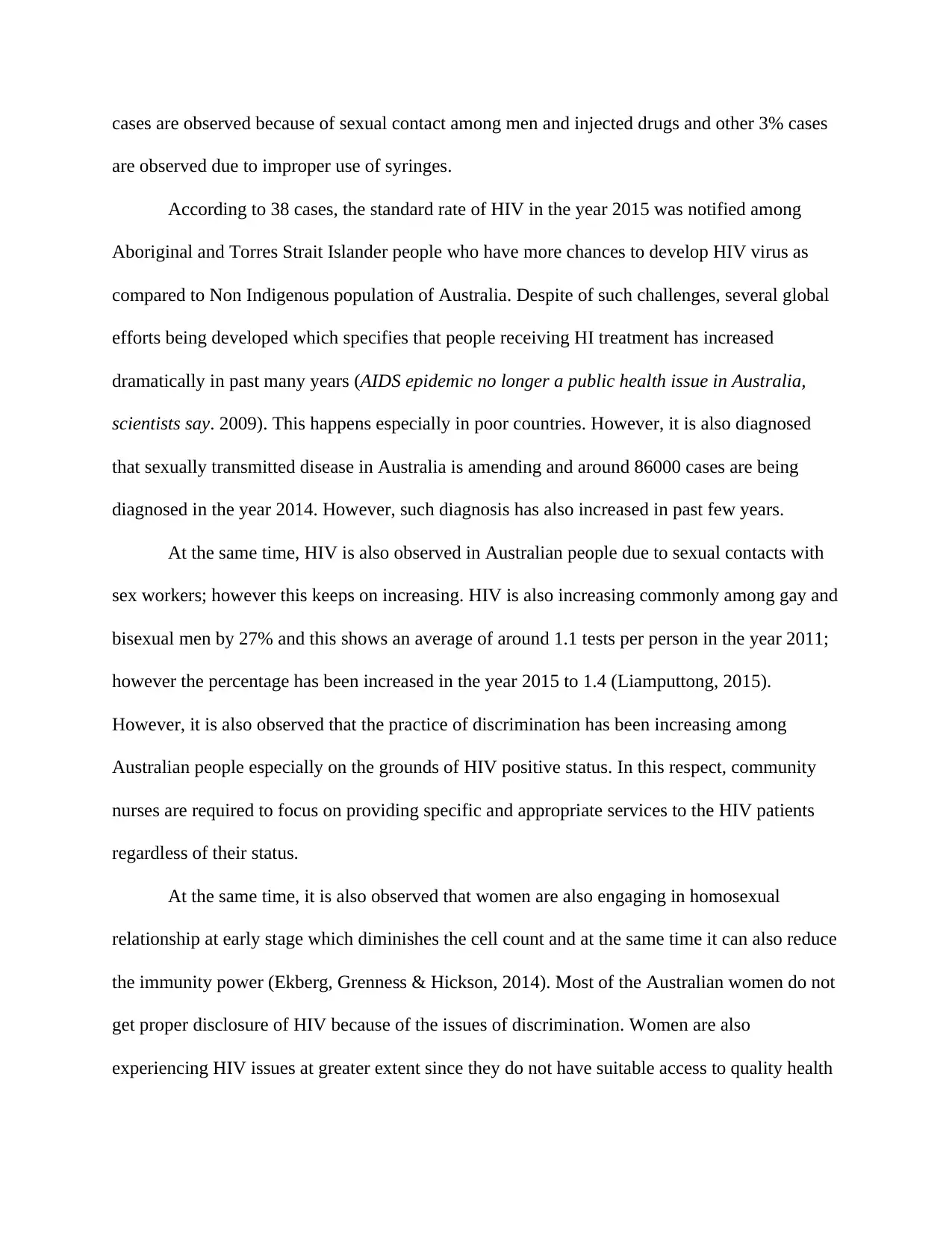
cases are observed because of sexual contact among men and injected drugs and other 3% cases
are observed due to improper use of syringes.
According to 38 cases, the standard rate of HIV in the year 2015 was notified among
Aboriginal and Torres Strait Islander people who have more chances to develop HIV virus as
compared to Non Indigenous population of Australia. Despite of such challenges, several global
efforts being developed which specifies that people receiving HI treatment has increased
dramatically in past many years (AIDS epidemic no longer a public health issue in Australia,
scientists say. 2009). This happens especially in poor countries. However, it is also diagnosed
that sexually transmitted disease in Australia is amending and around 86000 cases are being
diagnosed in the year 2014. However, such diagnosis has also increased in past few years.
At the same time, HIV is also observed in Australian people due to sexual contacts with
sex workers; however this keeps on increasing. HIV is also increasing commonly among gay and
bisexual men by 27% and this shows an average of around 1.1 tests per person in the year 2011;
however the percentage has been increased in the year 2015 to 1.4 (Liamputtong, 2015).
However, it is also observed that the practice of discrimination has been increasing among
Australian people especially on the grounds of HIV positive status. In this respect, community
nurses are required to focus on providing specific and appropriate services to the HIV patients
regardless of their status.
At the same time, it is also observed that women are also engaging in homosexual
relationship at early stage which diminishes the cell count and at the same time it can also reduce
the immunity power (Ekberg, Grenness & Hickson, 2014). Most of the Australian women do not
get proper disclosure of HIV because of the issues of discrimination. Women are also
experiencing HIV issues at greater extent since they do not have suitable access to quality health
are observed due to improper use of syringes.
According to 38 cases, the standard rate of HIV in the year 2015 was notified among
Aboriginal and Torres Strait Islander people who have more chances to develop HIV virus as
compared to Non Indigenous population of Australia. Despite of such challenges, several global
efforts being developed which specifies that people receiving HI treatment has increased
dramatically in past many years (AIDS epidemic no longer a public health issue in Australia,
scientists say. 2009). This happens especially in poor countries. However, it is also diagnosed
that sexually transmitted disease in Australia is amending and around 86000 cases are being
diagnosed in the year 2014. However, such diagnosis has also increased in past few years.
At the same time, HIV is also observed in Australian people due to sexual contacts with
sex workers; however this keeps on increasing. HIV is also increasing commonly among gay and
bisexual men by 27% and this shows an average of around 1.1 tests per person in the year 2011;
however the percentage has been increased in the year 2015 to 1.4 (Liamputtong, 2015).
However, it is also observed that the practice of discrimination has been increasing among
Australian people especially on the grounds of HIV positive status. In this respect, community
nurses are required to focus on providing specific and appropriate services to the HIV patients
regardless of their status.
At the same time, it is also observed that women are also engaging in homosexual
relationship at early stage which diminishes the cell count and at the same time it can also reduce
the immunity power (Ekberg, Grenness & Hickson, 2014). Most of the Australian women do not
get proper disclosure of HIV because of the issues of discrimination. Women are also
experiencing HIV issues at greater extent since they do not have suitable access to quality health
⊘ This is a preview!⊘
Do you want full access?
Subscribe today to unlock all pages.

Trusted by 1+ million students worldwide
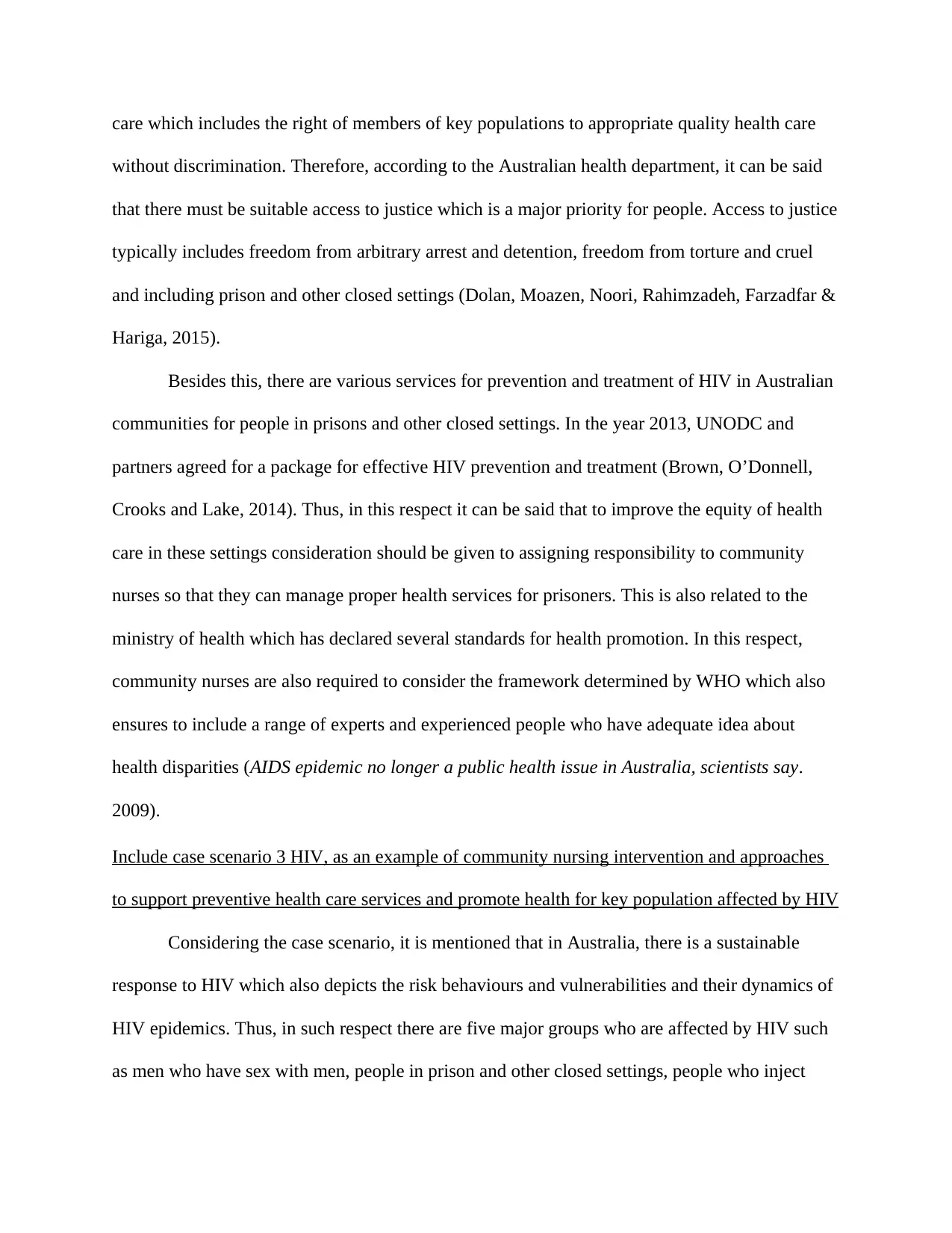
care which includes the right of members of key populations to appropriate quality health care
without discrimination. Therefore, according to the Australian health department, it can be said
that there must be suitable access to justice which is a major priority for people. Access to justice
typically includes freedom from arbitrary arrest and detention, freedom from torture and cruel
and including prison and other closed settings (Dolan, Moazen, Noori, Rahimzadeh, Farzadfar &
Hariga, 2015).
Besides this, there are various services for prevention and treatment of HIV in Australian
communities for people in prisons and other closed settings. In the year 2013, UNODC and
partners agreed for a package for effective HIV prevention and treatment (Brown, O’Donnell,
Crooks and Lake, 2014). Thus, in this respect it can be said that to improve the equity of health
care in these settings consideration should be given to assigning responsibility to community
nurses so that they can manage proper health services for prisoners. This is also related to the
ministry of health which has declared several standards for health promotion. In this respect,
community nurses are also required to consider the framework determined by WHO which also
ensures to include a range of experts and experienced people who have adequate idea about
health disparities (AIDS epidemic no longer a public health issue in Australia, scientists say.
2009).
Include case scenario 3 HIV, as an example of community nursing intervention and approaches
to support preventive health care services and promote health for key population affected by HIV
Considering the case scenario, it is mentioned that in Australia, there is a sustainable
response to HIV which also depicts the risk behaviours and vulnerabilities and their dynamics of
HIV epidemics. Thus, in such respect there are five major groups who are affected by HIV such
as men who have sex with men, people in prison and other closed settings, people who inject
without discrimination. Therefore, according to the Australian health department, it can be said
that there must be suitable access to justice which is a major priority for people. Access to justice
typically includes freedom from arbitrary arrest and detention, freedom from torture and cruel
and including prison and other closed settings (Dolan, Moazen, Noori, Rahimzadeh, Farzadfar &
Hariga, 2015).
Besides this, there are various services for prevention and treatment of HIV in Australian
communities for people in prisons and other closed settings. In the year 2013, UNODC and
partners agreed for a package for effective HIV prevention and treatment (Brown, O’Donnell,
Crooks and Lake, 2014). Thus, in this respect it can be said that to improve the equity of health
care in these settings consideration should be given to assigning responsibility to community
nurses so that they can manage proper health services for prisoners. This is also related to the
ministry of health which has declared several standards for health promotion. In this respect,
community nurses are also required to consider the framework determined by WHO which also
ensures to include a range of experts and experienced people who have adequate idea about
health disparities (AIDS epidemic no longer a public health issue in Australia, scientists say.
2009).
Include case scenario 3 HIV, as an example of community nursing intervention and approaches
to support preventive health care services and promote health for key population affected by HIV
Considering the case scenario, it is mentioned that in Australia, there is a sustainable
response to HIV which also depicts the risk behaviours and vulnerabilities and their dynamics of
HIV epidemics. Thus, in such respect there are five major groups who are affected by HIV such
as men who have sex with men, people in prison and other closed settings, people who inject
Paraphrase This Document
Need a fresh take? Get an instant paraphrase of this document with our AI Paraphraser
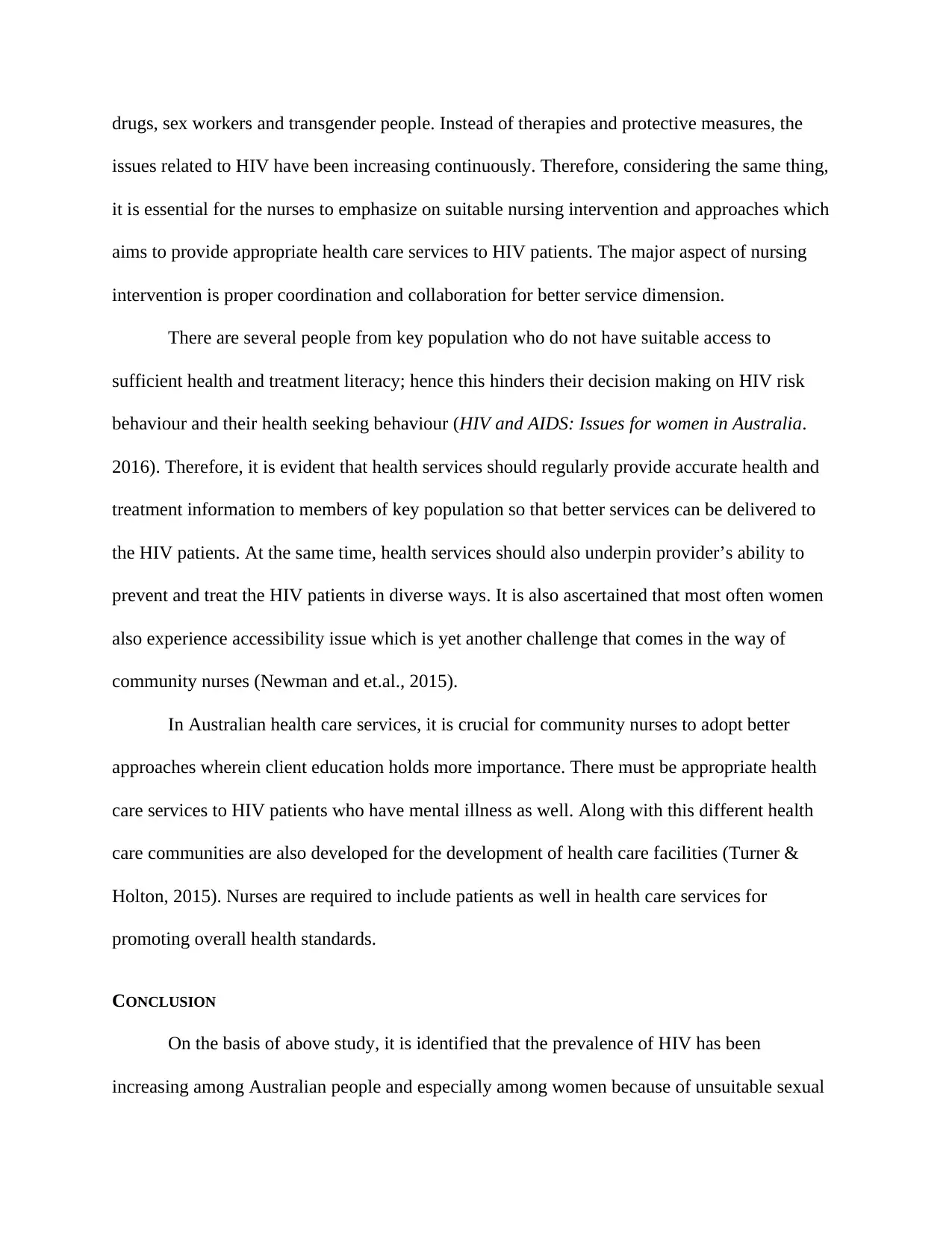
drugs, sex workers and transgender people. Instead of therapies and protective measures, the
issues related to HIV have been increasing continuously. Therefore, considering the same thing,
it is essential for the nurses to emphasize on suitable nursing intervention and approaches which
aims to provide appropriate health care services to HIV patients. The major aspect of nursing
intervention is proper coordination and collaboration for better service dimension.
There are several people from key population who do not have suitable access to
sufficient health and treatment literacy; hence this hinders their decision making on HIV risk
behaviour and their health seeking behaviour (HIV and AIDS: Issues for women in Australia.
2016). Therefore, it is evident that health services should regularly provide accurate health and
treatment information to members of key population so that better services can be delivered to
the HIV patients. At the same time, health services should also underpin provider’s ability to
prevent and treat the HIV patients in diverse ways. It is also ascertained that most often women
also experience accessibility issue which is yet another challenge that comes in the way of
community nurses (Newman and et.al., 2015).
In Australian health care services, it is crucial for community nurses to adopt better
approaches wherein client education holds more importance. There must be appropriate health
care services to HIV patients who have mental illness as well. Along with this different health
care communities are also developed for the development of health care facilities (Turner &
Holton, 2015). Nurses are required to include patients as well in health care services for
promoting overall health standards.
CONCLUSION
On the basis of above study, it is identified that the prevalence of HIV has been
increasing among Australian people and especially among women because of unsuitable sexual
issues related to HIV have been increasing continuously. Therefore, considering the same thing,
it is essential for the nurses to emphasize on suitable nursing intervention and approaches which
aims to provide appropriate health care services to HIV patients. The major aspect of nursing
intervention is proper coordination and collaboration for better service dimension.
There are several people from key population who do not have suitable access to
sufficient health and treatment literacy; hence this hinders their decision making on HIV risk
behaviour and their health seeking behaviour (HIV and AIDS: Issues for women in Australia.
2016). Therefore, it is evident that health services should regularly provide accurate health and
treatment information to members of key population so that better services can be delivered to
the HIV patients. At the same time, health services should also underpin provider’s ability to
prevent and treat the HIV patients in diverse ways. It is also ascertained that most often women
also experience accessibility issue which is yet another challenge that comes in the way of
community nurses (Newman and et.al., 2015).
In Australian health care services, it is crucial for community nurses to adopt better
approaches wherein client education holds more importance. There must be appropriate health
care services to HIV patients who have mental illness as well. Along with this different health
care communities are also developed for the development of health care facilities (Turner &
Holton, 2015). Nurses are required to include patients as well in health care services for
promoting overall health standards.
CONCLUSION
On the basis of above study, it is identified that the prevalence of HIV has been
increasing among Australian people and especially among women because of unsuitable sexual
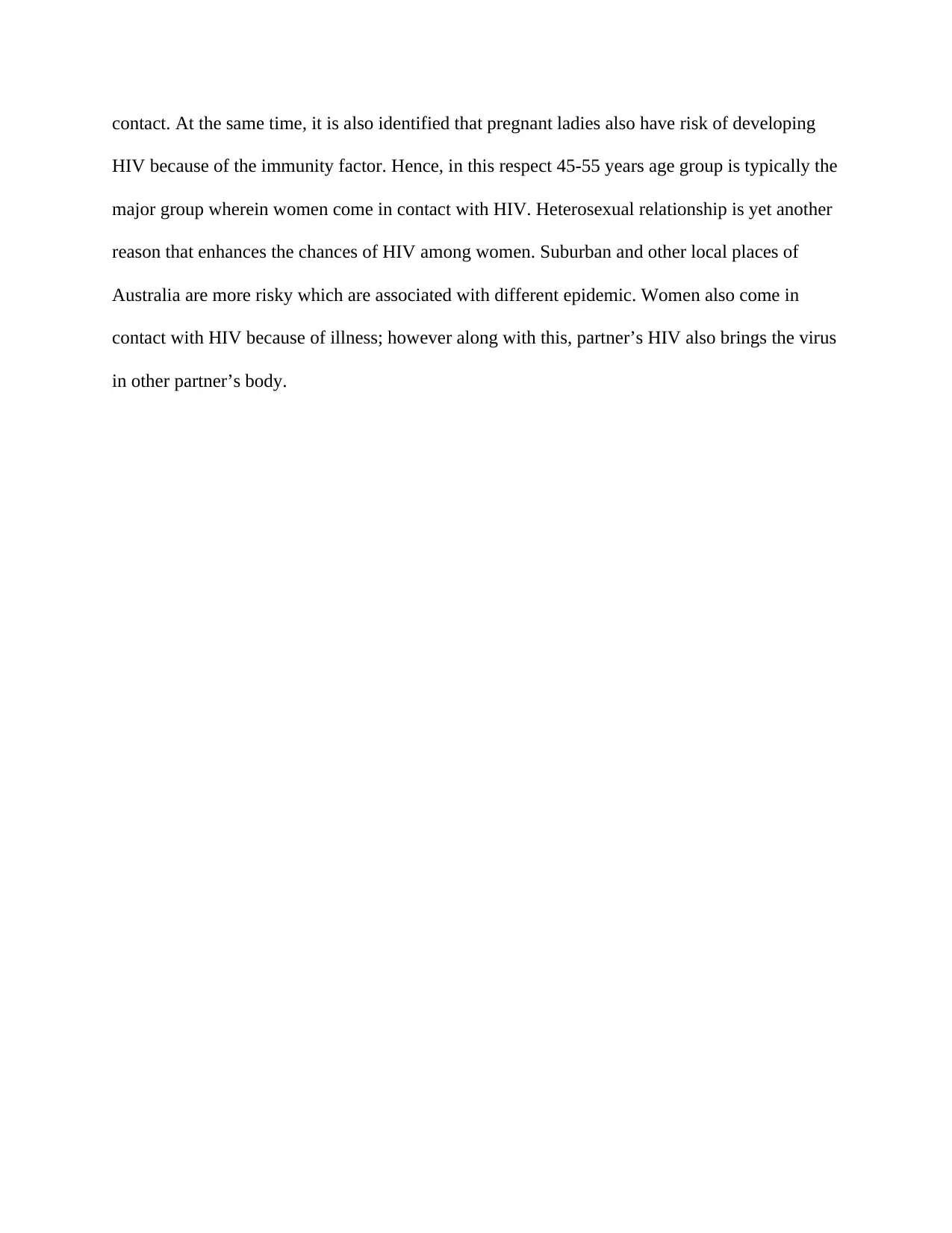
contact. At the same time, it is also identified that pregnant ladies also have risk of developing
HIV because of the immunity factor. Hence, in this respect 45-55 years age group is typically the
major group wherein women come in contact with HIV. Heterosexual relationship is yet another
reason that enhances the chances of HIV among women. Suburban and other local places of
Australia are more risky which are associated with different epidemic. Women also come in
contact with HIV because of illness; however along with this, partner’s HIV also brings the virus
in other partner’s body.
HIV because of the immunity factor. Hence, in this respect 45-55 years age group is typically the
major group wherein women come in contact with HIV. Heterosexual relationship is yet another
reason that enhances the chances of HIV among women. Suburban and other local places of
Australia are more risky which are associated with different epidemic. Women also come in
contact with HIV because of illness; however along with this, partner’s HIV also brings the virus
in other partner’s body.
⊘ This is a preview!⊘
Do you want full access?
Subscribe today to unlock all pages.

Trusted by 1+ million students worldwide
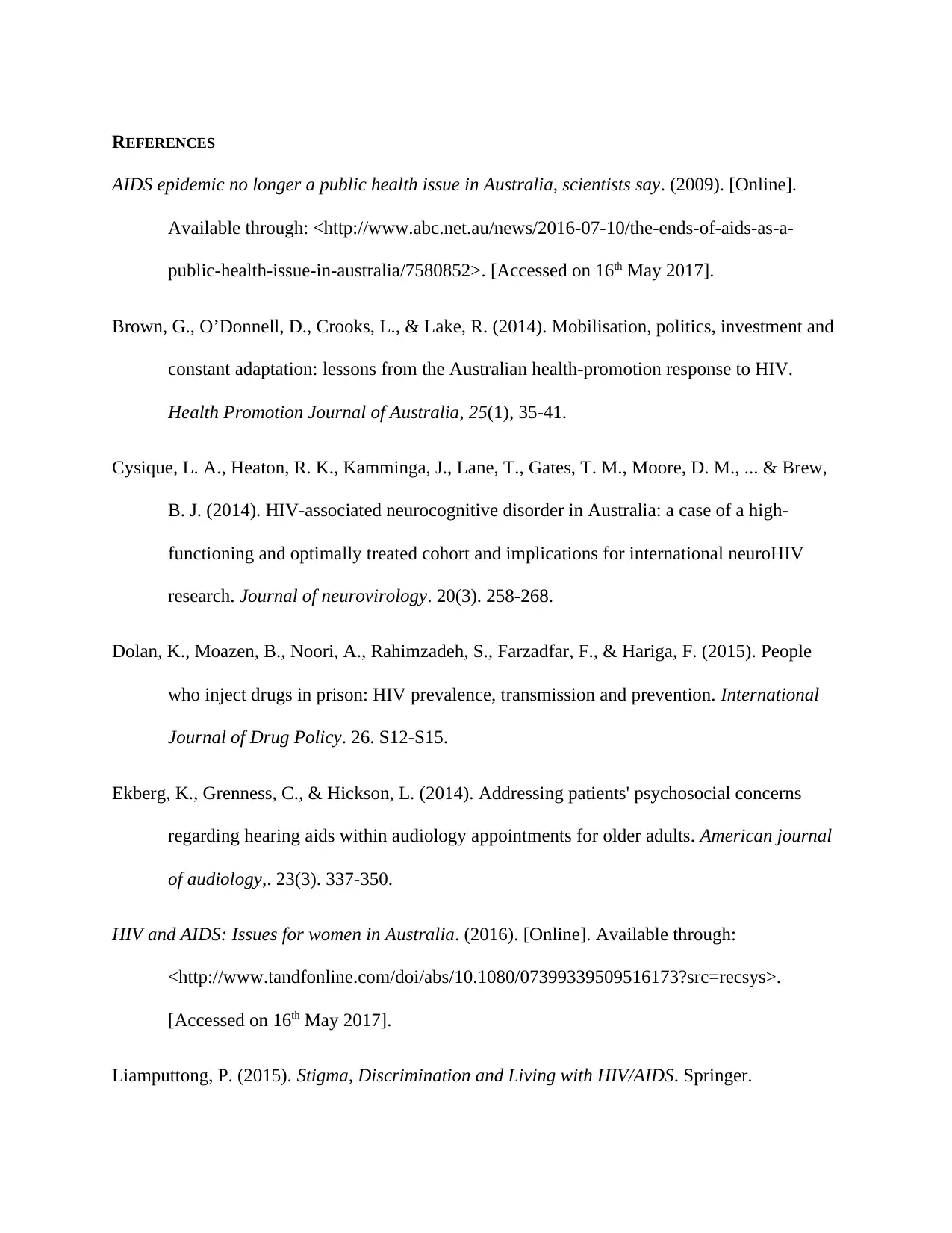
REFERENCES
AIDS epidemic no longer a public health issue in Australia, scientists say. (2009). [Online].
Available through: <http://www.abc.net.au/news/2016-07-10/the-ends-of-aids-as-a-
public-health-issue-in-australia/7580852>. [Accessed on 16th May 2017].
Brown, G., O’Donnell, D., Crooks, L., & Lake, R. (2014). Mobilisation, politics, investment and
constant adaptation: lessons from the Australian health-promotion response to HIV.
Health Promotion Journal of Australia, 25(1), 35-41.
Cysique, L. A., Heaton, R. K., Kamminga, J., Lane, T., Gates, T. M., Moore, D. M., ... & Brew,
B. J. (2014). HIV-associated neurocognitive disorder in Australia: a case of a high-
functioning and optimally treated cohort and implications for international neuroHIV
research. Journal of neurovirology. 20(3). 258-268.
Dolan, K., Moazen, B., Noori, A., Rahimzadeh, S., Farzadfar, F., & Hariga, F. (2015). People
who inject drugs in prison: HIV prevalence, transmission and prevention. International
Journal of Drug Policy. 26. S12-S15.
Ekberg, K., Grenness, C., & Hickson, L. (2014). Addressing patients' psychosocial concerns
regarding hearing aids within audiology appointments for older adults. American journal
of audiology,. 23(3). 337-350.
HIV and AIDS: Issues for women in Australia. (2016). [Online]. Available through:
<http://www.tandfonline.com/doi/abs/10.1080/07399339509516173?src=recsys>.
[Accessed on 16th May 2017].
Liamputtong, P. (2015). Stigma, Discrimination and Living with HIV/AIDS. Springer.
AIDS epidemic no longer a public health issue in Australia, scientists say. (2009). [Online].
Available through: <http://www.abc.net.au/news/2016-07-10/the-ends-of-aids-as-a-
public-health-issue-in-australia/7580852>. [Accessed on 16th May 2017].
Brown, G., O’Donnell, D., Crooks, L., & Lake, R. (2014). Mobilisation, politics, investment and
constant adaptation: lessons from the Australian health-promotion response to HIV.
Health Promotion Journal of Australia, 25(1), 35-41.
Cysique, L. A., Heaton, R. K., Kamminga, J., Lane, T., Gates, T. M., Moore, D. M., ... & Brew,
B. J. (2014). HIV-associated neurocognitive disorder in Australia: a case of a high-
functioning and optimally treated cohort and implications for international neuroHIV
research. Journal of neurovirology. 20(3). 258-268.
Dolan, K., Moazen, B., Noori, A., Rahimzadeh, S., Farzadfar, F., & Hariga, F. (2015). People
who inject drugs in prison: HIV prevalence, transmission and prevention. International
Journal of Drug Policy. 26. S12-S15.
Ekberg, K., Grenness, C., & Hickson, L. (2014). Addressing patients' psychosocial concerns
regarding hearing aids within audiology appointments for older adults. American journal
of audiology,. 23(3). 337-350.
HIV and AIDS: Issues for women in Australia. (2016). [Online]. Available through:
<http://www.tandfonline.com/doi/abs/10.1080/07399339509516173?src=recsys>.
[Accessed on 16th May 2017].
Liamputtong, P. (2015). Stigma, Discrimination and Living with HIV/AIDS. Springer.
Paraphrase This Document
Need a fresh take? Get an instant paraphrase of this document with our AI Paraphraser
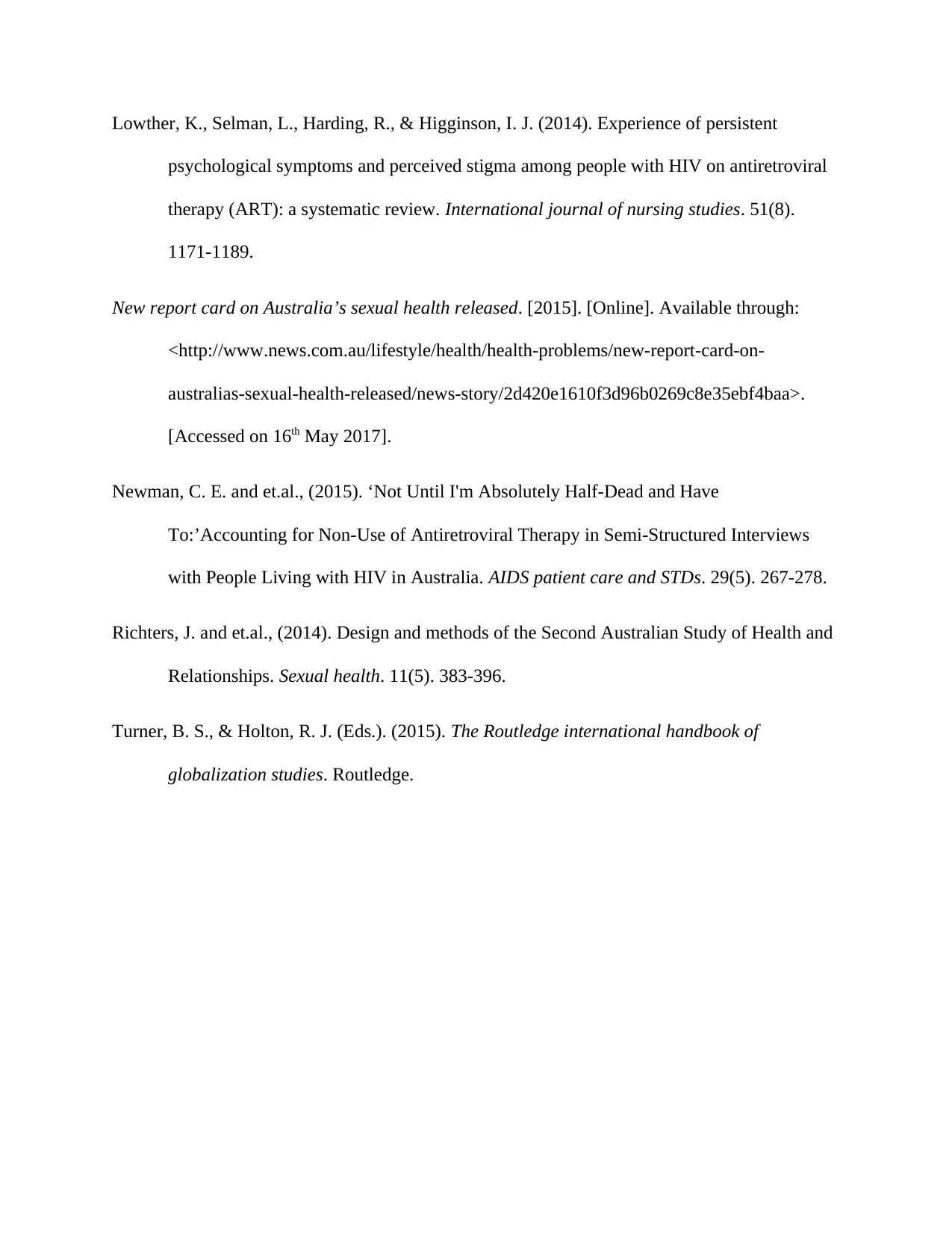
Lowther, K., Selman, L., Harding, R., & Higginson, I. J. (2014). Experience of persistent
psychological symptoms and perceived stigma among people with HIV on antiretroviral
therapy (ART): a systematic review. International journal of nursing studies. 51(8).
1171-1189.
New report card on Australia’s sexual health released. [2015]. [Online]. Available through:
<http://www.news.com.au/lifestyle/health/health-problems/new-report-card-on-
australias-sexual-health-released/news-story/2d420e1610f3d96b0269c8e35ebf4baa>.
[Accessed on 16th May 2017].
Newman, C. E. and et.al., (2015). ‘Not Until I'm Absolutely Half-Dead and Have
To:’Accounting for Non-Use of Antiretroviral Therapy in Semi-Structured Interviews
with People Living with HIV in Australia. AIDS patient care and STDs. 29(5). 267-278.
Richters, J. and et.al., (2014). Design and methods of the Second Australian Study of Health and
Relationships. Sexual health. 11(5). 383-396.
Turner, B. S., & Holton, R. J. (Eds.). (2015). The Routledge international handbook of
globalization studies. Routledge.
psychological symptoms and perceived stigma among people with HIV on antiretroviral
therapy (ART): a systematic review. International journal of nursing studies. 51(8).
1171-1189.
New report card on Australia’s sexual health released. [2015]. [Online]. Available through:
<http://www.news.com.au/lifestyle/health/health-problems/new-report-card-on-
australias-sexual-health-released/news-story/2d420e1610f3d96b0269c8e35ebf4baa>.
[Accessed on 16th May 2017].
Newman, C. E. and et.al., (2015). ‘Not Until I'm Absolutely Half-Dead and Have
To:’Accounting for Non-Use of Antiretroviral Therapy in Semi-Structured Interviews
with People Living with HIV in Australia. AIDS patient care and STDs. 29(5). 267-278.
Richters, J. and et.al., (2014). Design and methods of the Second Australian Study of Health and
Relationships. Sexual health. 11(5). 383-396.
Turner, B. S., & Holton, R. J. (Eds.). (2015). The Routledge international handbook of
globalization studies. Routledge.
1 out of 11
Related Documents
Your All-in-One AI-Powered Toolkit for Academic Success.
+13062052269
info@desklib.com
Available 24*7 on WhatsApp / Email
![[object Object]](/_next/static/media/star-bottom.7253800d.svg)
Unlock your academic potential
Copyright © 2020–2025 A2Z Services. All Rights Reserved. Developed and managed by ZUCOL.





